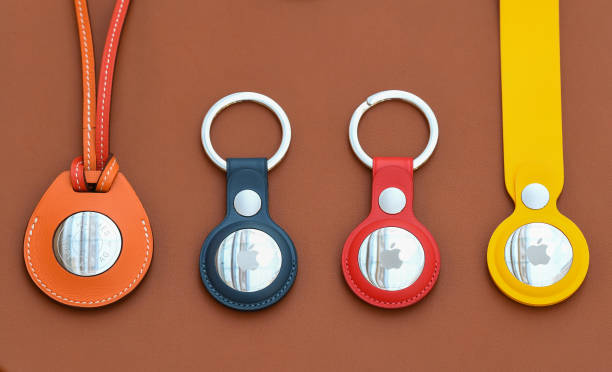If you’re one of those kinds of people who would lose their head if it wasn’t attached, you may have recently been advised to purchase Apple AirTags to keep track of some of your most important belongings. AirTags are advertised by Apple Computers as “a super easy way to keep track of your stuff,” designed for keeping on your car keys, in your backpack, and even in your child’s pocket, if you’re venturing into an unknown space. The quarter-sized discs easily pair up with your Apple ID and offer radar detection via the Find My app, allowing you to track down your lost belongings with relative ease.
But how exactly do AirTags work? If you’re not the most tech-savvy individual, you may have questions and concerns about the use and efficacy of these bold new trackers, as well as a few fears about their application in regard to your public safety. Luckily, we’ve got you covered, with a comprehensive breakdown of the AirTags’ inner workings, and a basic explanation for those who don’t follow each year’s Worldwide Developers Conference with a notebook and pen in hand. Without any further preamble, let’s dive right into the explanation, and ensure that you can track your belongings without issue.
How Do AirTags Work?
Despite their advanced tracking capabilities, AirTags actually don’t connect to any GPS device at all. Their tracking is monitored exclusively through Bluetooth, via a private and secure signal which can only be tracked by devices on your network. Specifically, AirTags operate on a form of Bluetooth technology known as Ultra-Wide Band, which triangulates exact locations based on extremely limited data. iPhones, and other devices which utilize UWB tech, send out signals every 2 nanoseconds, allowing them to precisely dictate the exact distance and direction the AirTag is from your home device. Think of this technology like a fruit bat’s sonar detection. The UWB tech sends out signals in waves which spread their radius until ultimately pinpointing the receiver.
Unlike a fruit bat, however, your Apple devices can pinpoint the location of AirTags from miles away, as long as they stay within range of any iPhone. While the trackers can only be found using your personal devices, their locations are determined using the entire Apple network, which is composed of Apple products all over the world. This means that you can still track the location of your AirTags from cities, states, and even countries away. AirTags tend to lose their pinpointing capability once they stray roughly 50 meters from another Apple device. The only way you’ll truly lose one is if it gets dropped into the ocean, or left in a ditch hundreds of miles from civilization.
Are AirTags Safe?
Though it can be scary to keep trackable devices on your person, AirTags are remarkably safe. Apple has recently implemented features that will alert you when it seems as though a foreign AirTag is following you without your knowledge. This means other Apple users can’t employ the devices to stalk you without alerting you to their presence. The Bluetooth connection capability of the tiny little discs are extremely secure, and offer some of the best location triangulation tech currently on the consumer market.
Furthermore, AirTags connect to your Apple ID through end-to-end encryption, so the likelihood of a nefarious person or foreign entity using them to track you is extremely unlikely, unless you’re in the business of giving away your login information. Even still, most Apple accounts are paired with 2-factor authentication, which should make AirTags one of the safest devices in tech. While it is always advised to keep your wits about you and remain aware of the risks associated with new tech, general consumers have very little to worry about when it comes to these handy Bluetooth devices.
What Are The Best Uses For AirTags?
As mentioned, AirTags are extremely helpful when attached to keychains, wallets, or left in luggage while traveling. If your luggage is lost during air travel, for instance, an AirTag will help you to triangulate the position of your bags, making them easier for the appropriate airline staff to find and return. Some users have even taken to placing AirTags on the collars of their pets, as the devices offer an easy, discrete, and durable tracker, with no monthly subscription fees. Just bear in mind that AirTags are not fully waterproof, and will likely become damaged if they are ever submerged underwater. The possibilities for AirTags are seemingly endless, allowing some especially forgetful people to buy multiple Tags to track each of their important belongings.
Can AirTags Be Used With Non Apple Devices?
Unfortunately, AirTags cannot be paired with non Apple devices at this time, since the discs are only designed to sync with Apple exclusive tech such as the Find My app. For a useful Android alternative, you can look into Tile trackers or any number of off-brand Bluetooth devices. Still, the public release of AirTags should allow for some new and exciting innovation in the world of tracking devices. This means that there will more than likely be a host of new devices on the market to compete with the Apple exclusive Tags any day now.





